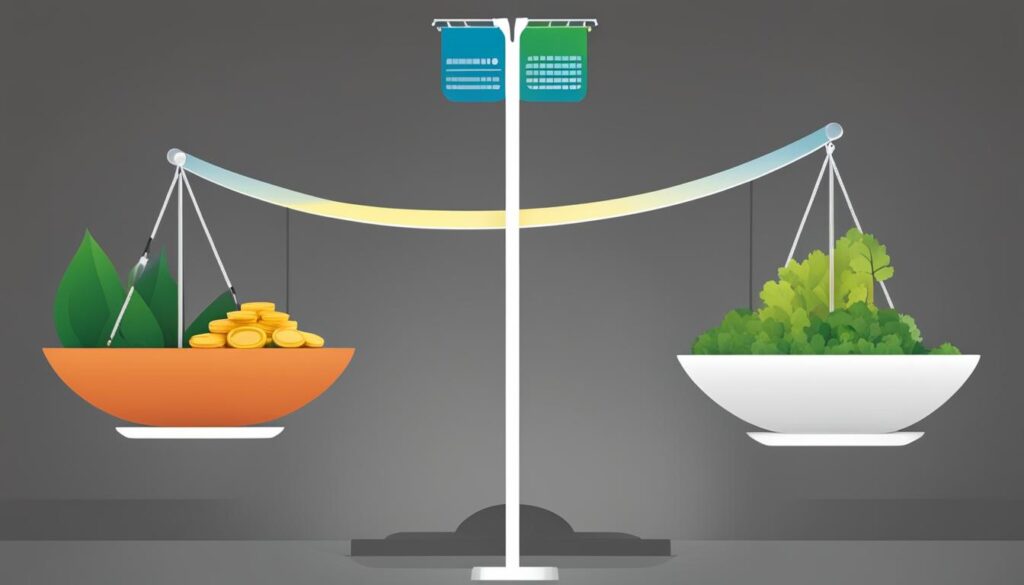From the groundbreaking 1979 paper by Daniel Kahneman and Amos Tversky, the concept of loss aversion theory has continued to fascinate me as an influential force in the realm of behavioral economics. This seminal work on prospect theory revealed a prevalent human tendency: we often emphasize avoiding losses over acquiring equivalent gains. Throughout my explorations, it’s become evident that understanding and managing this instinctive bias is crucial for personal growth and self improvement. It’s a psychological fulcrum that can either ground us in stagnation or launch us into the stratosphere of profound development.
In the pursuit of a mindset that warmly embraces challenges, the fear of loss can be a formidable adversary. However, acknowledging this inherent aversion to risk can be the first step in restructuring our decision-making processes. By consciously shifting our perspective, we transcend the confines of comfort zones, and this very act of bravery becomes the catalyst for a transformative journey of personal development. Let’s delve deeper into how this complex facet of human psychology functions and how it might, under the right conditions, serve as a springboard rather than an anchor.
Key Takeaways
- Loss aversion theory, pioneered by Kahneman and Tversky, plays a significant role in decision-making and development.
- Understanding our natural inclination to avoid losses over gaining rewards can illuminate barriers to personal growth.
- Confronting our fear of loss is essential for embracing risk and opening doors to new development opportunities.
- By redirecting our focus from potential losses to potential gains, we can adopt a more conducive mindset for self improvement.
- Appreciating the impact of loss aversion on our choices helps us better navigate the path to purposeful personal development.
Understanding the Basics of Loss Aversion Theory
In the landscape of behavioral economics, one concept consistently reshapes how I grasp the underpinnings of human decision-making—Loss Aversion Theory. Stemming from the groundbreaking work of Kahneman and Tversky, this theory has been a linchpin in my exploration into the cognitive biases skewing the interpretation of risk.
The Origin of Prospect Theory
The inception of prospect theory dates back to 1979, conceived by the collaborative genius of Daniel Kahneman and Amos Tversky. Their in-depth analysis and subsequent formulation elucidated the intricate manners in which individuals process potential gains and losses, spotlighting the irregularities that define our choices. Their findings pivoted away from the expected utility theory, introducing an approach that reflected real-world behaviors over hypothetical perfection.
Defining Loss Aversion in Behavioral Economics
As my fascination with this field deepens, I often find myself simplifying loss aversion as the principle where the pain of losing is more impactful than the pleasure of an equivalent gain. It is this asymmetry in emotional impact that guides, and sometimes misguides, our economic preferences and risk assessments.
Key Findings and Psychological Insights
The more I delve into the implications of prospect theory, the clearer I see our inherent bias towards avoiding losses, a phenomenon backed by a myriad of psychological studies. One standout aspect is our overvaluation of low probabilities, which often leads us to overestimate the likelihood and impact of rare events—reshaping not only my own perspective but also global approaches to risk interpretation in both finance and daily choices.
Global Validation of Kahneman and Tversky’s Prospect Theory
The rigorous examination of Prospect Theory on a global scale is critical to establishing its universal relevance in behavioral economics. By conducting a replication study that spans various countries and cultures, the bedrock principles of this theory face the ultimate test of global research applicability. My interest in this domain is more than academic; it’s about understanding the human psyche that transcends borders.
Replication Study Across Countries and Cultures
In my exploration of recent studies building on Kahneman and Tversky’s work, I encountered the multifaceted research led by renowned behavioral scientist Kai Ruggeri. His approach involved the diversification of tests in 19 different countries, spanning 13 distinct languages, making it a truly expansive piece of global research. The study modified the original experiments in terms of local currency values, an insightful tactic to ensure contextual relevance.
The Role of Local Currencies in Behavioral Studies
The decision to adjust currency values to their 2019 equivalent in each locality was a stroke of genius, further cultivating the robustness of the findings. Through this meticulous calibration, Ruggeri’s team demonstrated that local economic factors, when squared accurately within the study’s framework, provide a more precise gauge of loss aversion across different monetary systems. It helped me fathom the profound impact of local currency values in understanding behavioral economics on a worldwide stage.
Why Loss Aversion Theory Can Stifle Development
As I delve into the complexities of loss aversion theory, I often encounter its paradoxical nature. On the one hand, it’s a natural protective mechanism; on the other, it acts as a barrier to stifled development. Through my examination of risk assessment, I’ve seen that bias towards avoiding losses can deter decision-makers from seizing opportunities that, albeit risky, may offer substantial growth potential. Consider a scenario where an individual faces the choice of maintaining their current position or pursuing a higher one with inherent challenges. The natural inclination to avert the perceived risks can lead to irrational decision-making, where possible gains are undervalued compared to potential losses.
A common thread in these situations is a disproportionate reaction to the notion of loss which I believe can and does result in consequences for personal advancement. To illustrate this, let’s look at a comparative analysis:
| Risk Type | Loss Aversion Impact | Potential Beneficial Outcome |
|---|---|---|
| Professional | Declining to apply for a promotion due to fear of rejection or change | Promotion could lead to career advancement and skill development |
| Financial | Hesitance to invest in an opportunity due to fear of monetary loss | Investment could yield significant financial returns |
| Educational | Avoiding further education because of the time investment and uncertainty of outcome | Additional qualifications could open new paths and enrich expertise |
| Innovative | Holding back from the implementation of new ideas due to the risk of failure | Success could establish leadership and a change-maker status |
From my perspective, gauging the extent of loss aversion’s impact requires not only understanding its psychological underpinnings but also actively engaging in decision-making strategies that minimize its effect. By re-framing the approach to perceived risks and emphasizing the constructive outcomes of a growth mindset, one can overcome the shackles of loss aversion.
Indeed, the challenge lies in recognizing that what seems like a safeguarding intuition may, in truth, be an impediment to unlocking one’s full potential.
Applications of Loss Aversion Theory in Personal Development
For many of us, the journey of personal development and professional growth is rife with the challenge of overcoming inherent fears related to potential losses. As I delved deeper into the realm of self-improvement, I recognized that the principles of loss aversion theory can be transformed into actionable strategies. These insights equip us with the capability to tackle the psychological hurdles that stand in the way of our ambition.
Overcoming Fear of Loss in Professional Growth
Embracing the concept of loss aversion has been a game changer in my professional life. The tools of personal development applications allow me to confront inevitable risks while focusing on long-term benefits. Through a structured approach, I’ve learned to weigh opportunities against potential losses more effectively, which cultivates a balanced mindset conducive to professional growth.
Impact on Self-improvement Strategies
The distillation of loss aversion theory into practical self-improvement strategies has charted a clear path forward in my personal development journey. I’ve cultivated habits and decision-making processes that wield the fears of loss as a catalyst for growth rather than as paralyzing agents. Below is a table outlining both the challenges posed by loss aversion and the respective tactics that have propelled my self-improvement:
| Loss Aversion Challenge | Self-improvement Strategy | Outcome in Personal Development |
|---|---|---|
| Risk aversion leading to stagnation | Emphasis on learning and skills acquisition | Enhanced expertise and adaptability |
| Overvaluation of immediate security over potential gains | Setting incremental and achievable goals | Consistent progress and motivation |
| Fear of financial loss impeding investment in one’s self | Strategic planning and budgeting for self-investment | Increased professional value and opportunities |
The reflection on and subsequent application of loss aversion theory have been nothing short of transformative in fostering my professional and personal evolution. These principles have unlocked new doors and allowed me to view challenges through a lens of opportunity and growth—an empowering shift in mindset for anyone on the path to self-improvement.
Neurological Underpinnings of Loss Aversion
In exploring the intricate web of decision-making, I delve into neurological studies that focus on the brain’s reward system and its response to potential gains versus losses. Groundbreaking research has uncovered how our brains process these economic variables, reflecting the manifestation of loss aversion at a biological level.
Studies on Activity in the Brain’s Reward Circuitry
When I consider how the brain reacts to rewards, it’s fascinating to see the dance of neurotransmitters and brain regions involved. Functional MRI scans have revealed that as the possibility of rewards increase, so does the activity in the brain’s pleasure centers, such as the nucleus accumbens. However, this activity notably diminishes when confronted with possible losses, illustrating the inherent preference our neurology has towards gains.
How Different Brain Regions Process Gains and Losses
The intricacies of how our brain evaluates gains versus losses are intricate and captivating. Various regions, from the amygdala to the prefrontal cortex, interact in complex ways to forge our perceptions of risk and reward.
| Brain Region | Response to Gains | Response to Losses |
|---|---|---|
| Nucleus Accumbens | Increased Activation | Reduced Activation |
| Amygdala | Moderate Activation | Heightened Activation |
| Prefrontal Cortex | Rational Processing | Profit and Loss Balancing |
| Insula | Anticipation of Reward | Risk Evaluation |
The data indicates that the insula, for example, plays a pivotal role in predicting risk-averse behavior, particularly in response to potential losses, while the prefrontal cortex is tasked with balancing the cognitive aspect of these economic decisions. The amygdala’s response pattern suggests it to be a seat of emotional reactions to loss, emphasizing the aversion phenomenon observed in behaviors influenced by prospect theory.
As a journalist investigating the inner workings of loss aversion, I find these neurological foundations not only fascinating but also critical in understanding why we often favor potential gains differently from losses. It’s a journey deep into the biological blueprints that shape our financial decisions and, ultimately, our lives.
Effects of Loss Aversion on Health Decision-Making
Understanding how loss aversion influences health decision-making is crucial in the grand scheme of preventive care and the deployment of effective behavioral interventions. It’s no secret that many individuals shy away from what could be life-saving screenings or treatments, not out of negligence, but due to an inherent bias against the perceived potential losses—be it financial, time, or even emotional discomfort.
I’ve observed that the way health information is presented can dramatically sway a person’s decisions. If, for example, a smoking cessation program emphasizes the loss of health and quality of life, rather than the potential gains from quitting, individuals affected by loss aversion are more likely to take notice. This is a powerful tool for healthcare providers who aim to encourage more proactive measures towards preventive care among their patients.
Loss aversion can greatly deter one’s commitment to routine health checks or participation in preventative programs. As such, understanding this can help us frame health messages in a way that resonates more profoundly with our innate decision-making processes.
It’s not just about highlighting the negative impacts though—balance is key. Integrating positive reinforcement alongside the potential losses forms a potent recipe for motivating individuals to take their health into their own hands. With the combination of these strategies, the design of behavioral interventions can become more sophisticated, leading to a higher rate of engagement in health decision-making.
- Address psychological barriers with empathy
- Utilize loss aversion to motivate without paralyzing
- Balance messaging with positive reinforcement
In my work, I’ve seen how tailored health messages can lead to beneficial shifts in behavior. There’s significant potential for improving health outcomes by leveraging the principles behind loss aversion, both in preventative and reactive healthcare settings.
Cross-Cultural Perspectives on Risk and Loss Aversion
As someone invested in understanding the myriad ways in which culture impacts our decisions, I find the interplay between cultural differences in risk perception and cross-cultural decision-making particularly fascinating. It’s clear that cultural context molds our attitudes toward risk and, by extension, the phenomenon of loss aversion. Let’s delve into the subtleties of how societies perceive risk and make decisions that are invariably colored by their cultural backgrounds.
Contrasting Perceptions of Loss Across Societies
Diverse cultural narratives and societal values play a significant role in shaping our responses to potential losses. For instance, societies with a collectivist orientation may exhibit higher degrees of risk aversion due to a stronger emphasis on communal harmony and the avoidance of collective loss. On the other hand, individualistic cultures potentially foster greater acceptance of risk, as personal achievement and autonomy are highly valued. These cultural nuances are crucial for understanding the global mosaic of risk perception.
Influence of Cultural Background on Decision-Making
The intricate tapestry of global cultures influences not just attitudes toward loss but the very mechanisms of decision-making itself. When faced with a decision involving potential risks, individuals often turn to culturally informed heuristic methods. These methods, developed within specific cultural confines, guide their judgment and choices. Recognizing this, organizations and policy-makers are beginning to tailor their strategies to ensure they resonate within varied cultural paradigms. Below is an overview comparing cross-cultural responses to risk:
| Culture Type | Risk Perception | Preferred Decision-Making Style | Impact on Loss Aversion |
|---|---|---|---|
| Collectivist | More risk-averse | Group consensus | Higher loss aversion due to collective impact concerns |
| Individualist | More risk-tolerant | Independent and self-reliant | Lower loss aversion with focus on personal gains |
| Uncertainty Avoidance High | Highly sensitive to uncertainty, perceives higher risk | Structured and detailed planning | Increased loss aversion, preferring safe options |
| Uncertainty Avoidance Low | Comfortable with ambiguity, perceives less risk | Flexible and adaptable | Decreased loss aversion with openness to novel experiences |
In my professional exploration of these topics, it becomes increasingly evident that an acute awareness of cultural differences in risk perception and cross-cultural decision-making is vital. Incorporating this understanding into the framework of how products are marketed, policies are formulated, and communications are crafted is essential for global competency in today’s interconnected world.
Revisiting the Principles of Prospect Theory
As a journalist passionate about the nuances of decision-making, I’ve observed the remarkable advances in prospect theory that shed light on the human mind’s handling of uncertainty. The original theory, posited by Kahneman and Tversky, has branched out, leading to a sophisticated understanding of how we represent uncertainty in our choices.
Advances in Understanding Uncertainty and Choice
The recent progress in prospect theory intricately maps our relationship with uncertainty. Traditional models assumed a black-and-white scenario where choices were clear-cut with known outcomes. Now, it’s become apparent that there’s a gray area, a fog of uncertainty that we navigate through when we make decisions.
Researchers are now attuned to the differences in how we process uncertain scenarios versus certain ones, and it’s clear that this uncertainty representation has a profound impact on economics, psychology, and even day-to-day life choices.
Critical Analysis of Framing Effects
Framing effects stand at the forefront of contemporary behavioral psychology research. It’s fascinating how the presentation of similar information in different contexts can lead to divergent decisions, showcasing the elasticity of our cognitive processes. Studies on framing effects analysis possess the potential to revolutionize not just theories, but also practical applications in fields ranging from marketing to public health.
Understanding how our sense of value and loss can be manipulated or influenced by mere rephrasing or restructuring of information has elucidated the importance of communication in any domain where choices are made. These insights inform a holistic approach to the advances in prospect theory, giving my readers a comprehensive understanding of modern decision-making frameworks.
Implications of Loss Aversion for Policy and Economics
The concept of loss aversion plays a pivotal role in the realms of economics and public policy, crafting an understanding of how individuals make choices and the implications these choices have on economic systems. Integrating insights from Daniel Kahneman and Amos Tversky’s theories into consumer choice theory illuminates the underpinnings of economic decision-making, reshaping conventional models to incorporate psychological nuances. As a journalist exploring these deep connections, I find that the interplay between behavioral economics and policy design can unlock innovative strategies to enhance societal welfare.
Incorporating Loss Aversion into Consumer Choice Theory
Traditionally, consumer choice theory assumed rationality in consumer behavior; however, the introduction of loss aversion has refined our understanding of purchasing patterns. It’s not just about the cost and benefits on paper; it’s about the perceived value and the inherently human fear of losing out. As a journalist, it’s fascinating to delve into how these cognitive biases shape market dynamics and consumer preferences, leading to a more nuanced appreciation for the complexities of consumer behavior.
Informing Public Policy with Behavioral Insights
The application of behavioral economics transcends the market and becomes a tool for designing public policy. Loss aversion, a key facet of human behavior, influences policy efficacy – from taxation to healthcare. Policymakers are empowered to deploy interventions that better align with the human propensity to avoid losses, potentially driving more effective and impactful policies. Capturing the human element in policy planning is where the true intersection of psychology and economics reveals its profound potential to advance the public good.
As we continue to witness the expansion of behavioral insights in economic and policy strategies, the promise of a more empathetic and grounded approach to policymaking sparks optimism. Leveraging a deep understanding of loss aversion, we can develop public policy that anticipates and addresses real-world decision-making processes, aiming to foster a society that navigates economic and social challenges with a greater measure of grace and efficiency.
The Role of Loss Aversion in Modern Technologies
In my exploration of the interplay between human psychology and emerging technologies, I’ve come across intriguing developments where artificial intelligence stands out not only as a disruptor but also as a potential equalizer in decision-making processes. As modern technology’s role in overcoming bias becomes increasingly significant, AI emerges as a reliable resource to navigate through the maze of human judgement clouded by loss aversion.
AI’s Potential to Overcome Professional Bias
Consider professional settings, where choices are frequently colored by the fear of loss—missing out on a profitable contract, or making a poor investment decision. Traditional human-led analyses are prone to such biases, and here the prowess of AI in overcoming bias is most apparent. Rigorous algorithms rooted in large data sets provide a layer of objectivity that human decision-makers can depend upon, effectively detaching choices from the often irrational leanings dictated by loss aversion.
| Aspect of Decision-Making | Human Judgement | AI-Driven Approach |
|---|---|---|
| Emotional Influence | High (Loss aversion bias) | Low (Data-oriented) |
| Reliance on Historical Data | Selective (Confirmation bias) | Comprehensive (Pattern recognition) |
| Adaptability to New Information | Variable (Cognitive dissonance) | High (Continuous learning) |
| Consistency in Decision Quality | Inconsistent (Subject to human error) | Consistent (Automated accuracy) |
AI has the capability to revolutionize the way we approach problem-solving by stripping down layers of ingrained biases and providing insights built on empirical evidence alone. As I delve deeper into the potential of artificial intelligence to refine our judgement, it’s clear that technology’s role is pivotal in orchestrating a new era of transparency and impartiality in professional environments.
Structuring Development Goals with Positive Mentality
As I reflect on personal development, the cornerstone of progressive goal-setting is the cultivation of a positive mentality. I recognize that countering loss aversion—a prevalent hurdle—implies nurturing an optimistic outlook and reconciling my apprehensions about potential failures. Relinquishing such inhibitions is instrumental in constructing development goals that are not just ambitious, but also intrinsically rewarding.
Identifying and Countering Loss Averse Thought Patterns
In my journey of personal growth, I’ve discovered that the first step to countering loss aversion is identifying it. I’ve learned to recognize the signs: the reluctance to take risks, procrastination, and the discomfort felt when considering stepping out of my comfort zone. By acknowledging these patterns, I pave the way for psychological flexibility and resilience. I have enlisted the following strategies to challenge and reframe my loss averse inclinations:
- Acknowledging missed opportunities due to loss aversion in the past and analyzing their impact on my growth.
- Engaging in constructive self-talk that emphasizes the value of potential over the fear of loss.
- Setting incremental objectives that reward risk-taking, regardless of the outcome.
Strategies for Shifting Focus to Potential Gains
Embracing a mindset that prioritizes potential gains is a vital countermeasure to loss aversion. This shift in perspective galvanizes my development goals, nudging me toward embracing calculated risks. Below are the tactics I’ve employed to reorient my mindset:
- Visualizing success and the manifold benefits associated with achieving my development goals.
- Practicing gratitude for growth-oriented experiences, even when they involve stepping into the unknown.
- Establishing a practice of reflecting on daily achievements to foster an appreciation for progress over perfection.
These methods, woven into the fabric of my daily life, are incrementally shaping a future where the aversion to loss is but a distant echo, overtaken by the zeal for potential gains and self-realization.
Conclusion
Throughout this discourse on loss aversion theory, a central theme has emerged: while the theory provides a profound understanding of human decision-making, it also highlights a barrier to our development. This conclusion rests not simply on theoretical grounds but is buttressed by evidence from various fields—economics, psychology, and neuroscience—that support the pervasive influence of loss aversion on our behaviors. To live a life less bounded by the fear of loss, I recognize that I must actively work on overcoming loss aversion by challenging the impulses that tether me to the safe harbors of certainty.
Adopting a growth mindset is imperative for stepping beyond the invisible lines drawn by loss aversion. In light of this theory’s implications, my resolve is to recalibrate the scales on which risks and rewards are weighed. This isn’t a call to embrace risk recklessly; rather, it’s an acknowledgment that in my pursuit of personal and professional fulfillment, the act of taking calculated risks can be as intrinsic to progress as the endeavors themselves. By prioritizing learning, resilience, and adaptability, I open myself up to the untold richness of experiences that lie just beyond the fear of potential losses.
Ultimately, success is found not only in outcomes but in the journeys that shape us—the decisions that compel us to stretch the breadth of our capabilities and the setbacks that remind us of our resolve. I am reminded that to embrace risk is to acknowledge that growth is seldom a product of playing it safe, but rather the result of navigating uncharted waters with courage and an open heart. This understanding is what will propel me and many others toward seizing opportunities for advancement that might have once evaded us, bound by the invisible chains of loss aversion.
FAQ
What is Loss Aversion Theory?
Loss aversion theory is a principle in behavioral economics that suggests individuals tend to prefer avoiding losses to acquiring equivalent gains. It is rooted in the concept that the pain of losing is psychologically about twice as powerful as the pleasure of gaining. Formulated by Daniel Kahneman and Amos Tversky, it is a cornerstone of their prospect theory that describes how people choose between probabilistic alternatives that involve risk.
How does Loss Aversion Theory affect personal development?
Loss aversion can impact personal development by causing individuals to avoid risks and new opportunities due to the fear of potential loss. This can lead to stagnation and hindered professional growth, as personal advancement often requires embracing uncertainties and making decisions that may involve some risk.
What is Prospect Theory and how is it related to Loss Aversion?
Prospect theory, developed by Daniel Kahneman and Amos Tversky, is a behavioral economic theory that analyzes how individuals make decisions under risk. It posits that people value gains and losses differently, leading to potential irrational decisions when faced with uncertainty. Loss aversion is a key component of this theory, describing our innate tendency to prefer avoiding losses rather than acquiring gains.
Can understanding Loss Aversion Theory lead to better decision-making?
Yes, by understanding loss aversion theory, individuals can recognize their natural biases towards loss aversion and work towards making more balanced and rational decisions. This understanding can help in overcoming the fear of potential losses when making choices that could facilitate growth and improve outcomes in both personal and professional settings.
Has Prospect Theory been validated globally?
Yes, prospect theory has been validated on a global scale. A replication study led by Kai Ruggeri and his team across 19 countries confirmed the theory’s general applicability and high replication rate, highlighting its relevance across different cultural and economic contexts.
How does culture affect Loss Aversion?
Cultural background significantly influences one’s loss aversion as different societies have varying risk perceptions and responses to potential losses. This plays a critical role in decision-making processes, and understanding these cultural differences is vital to applying economic and policy decisions correctly in a cross-cultural context.
What is the role of Artificial Intelligence in addressing Loss Aversion?
Artificial intelligence can play a significant role in mitigating professional biases, including loss aversion. AI systems can help in making objective decisions by analyzing data without the emotional biases that typically influence human judgment, leading to more rational decision-making processes.
How can loss aversion potentially impact health-related decisions?
Loss aversion may cause individuals to underutilize preventive healthcare measures because the immediate apparent ‘loss’ of time, money, or effort can overshadow potential future health benefits. It also affects how health-related risks are perceived and can influence the effectiveness of behavioral interventions based on how they are framed in terms of losses versus gains.
Can loss aversion be integrated into economic and policy-making?
Yes, loss aversion is increasingly considered in economic and policy-making to account for the biases and irrationalities in human decision-making. By acknowledging how loss aversion affects consumer choices, policymakers can design interventions that are more aligned with actual human behavior, potentially leading to better public policy outcomes.
How can one counteract the effects of Loss Aversion?
To counteract loss aversion, one can focus on cultivating a growth mindset and positive mentality that emphasize the potential gains rather than the potential losses. This involves recognizing loss-averse thought patterns, restructuring goals to incorporate acceptable risks, and creating strategies that balance short-term hazards with long-term development aspirations.






